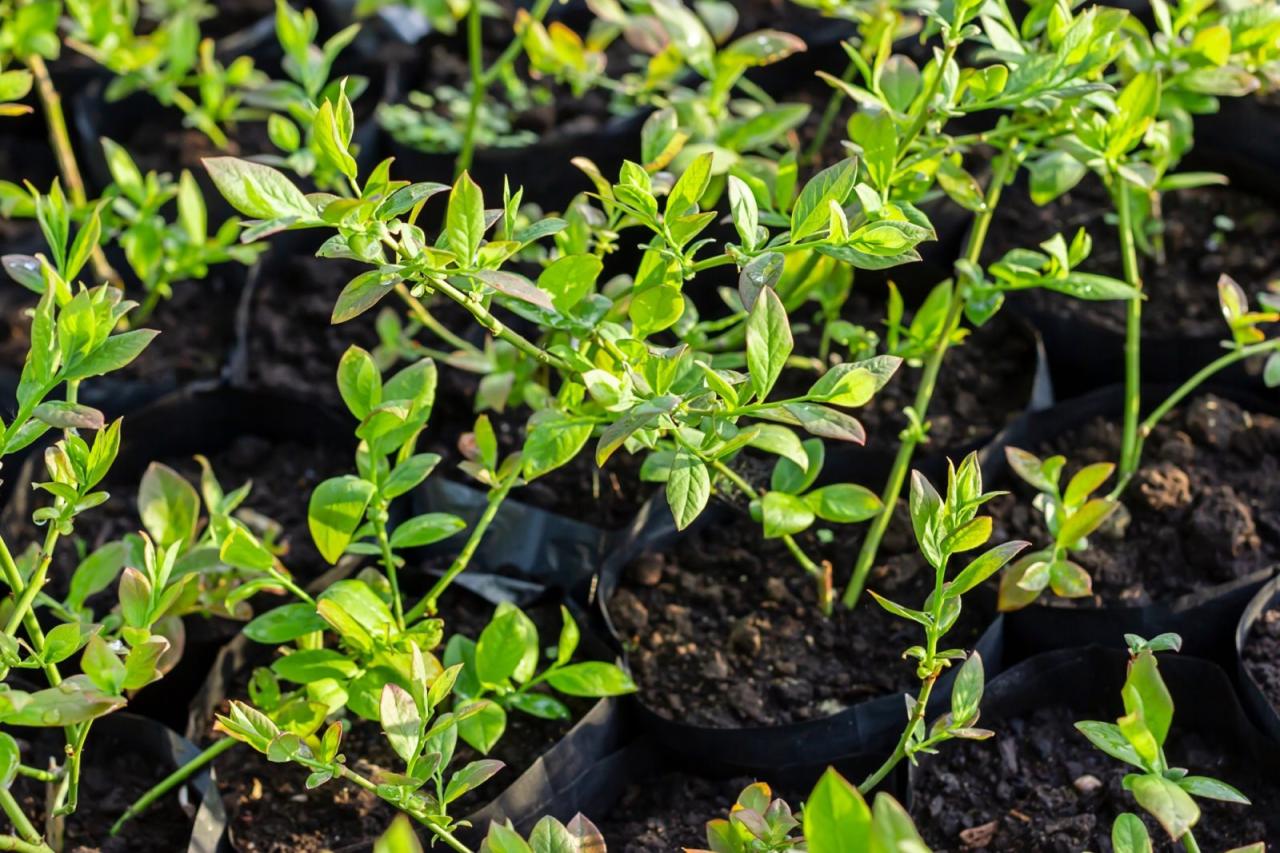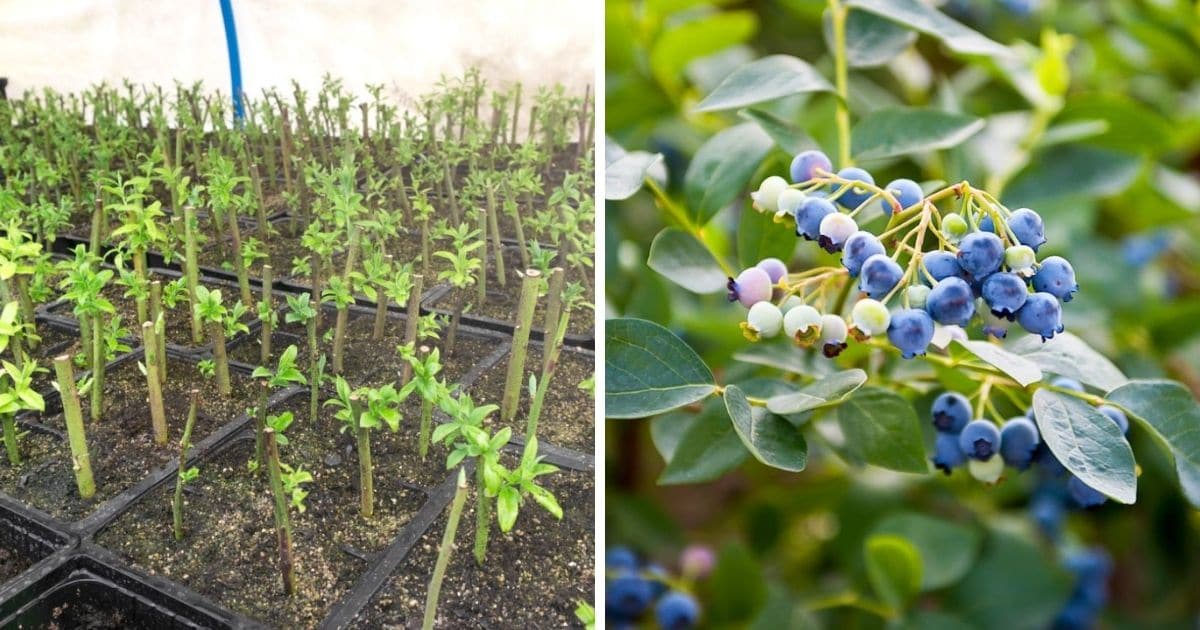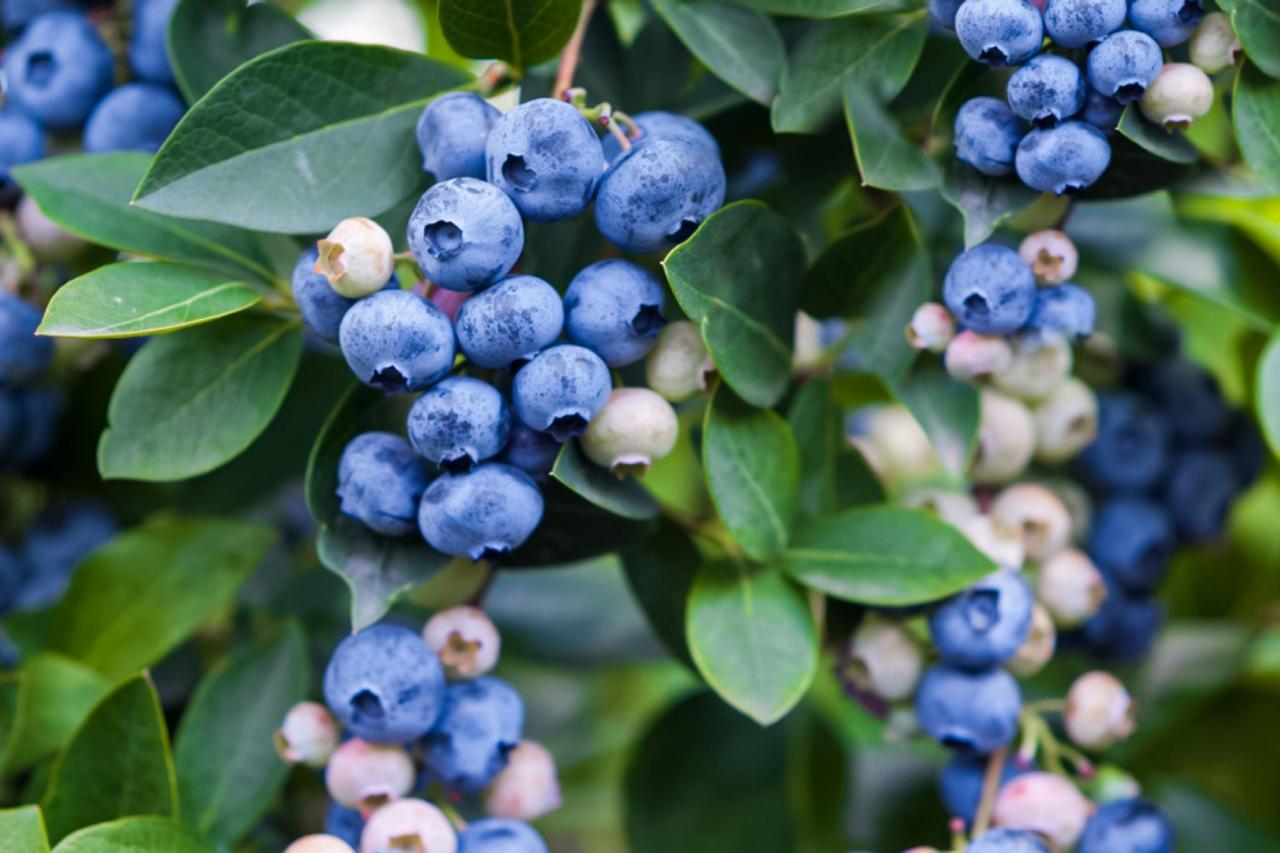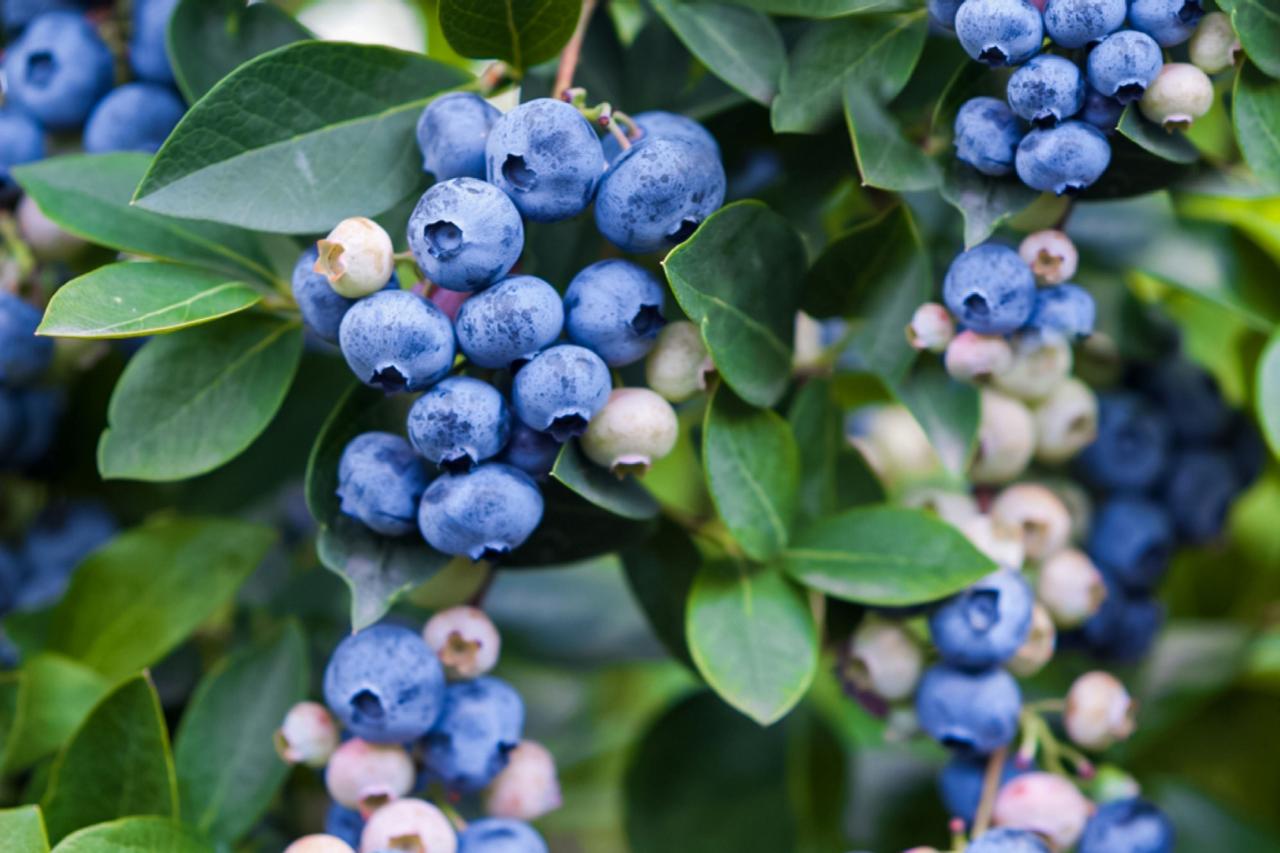The Best Techniques for Propagating Blueberry Bushes for Fresh Berries sets the stage for this enthralling narrative, offering readers a glimpse into a world of vibrant blueberries and the secrets to cultivating them from the comfort of your own backyard.
This comprehensive guide delves into the art and science of propagating blueberry bushes, equipping you with the knowledge and skills to nurture these delectable fruits. From understanding the different propagation methods to mastering the intricacies of cuttings, layering, and seed propagation, this journey explores the best practices for cultivating healthy, bountiful blueberry bushes.
Discover the secrets to selecting healthy parent plants, taking cuttings with precision, and creating thriving blueberry bushes through layering techniques. Learn how to prepare the perfect soil environment, provide optimal care for your newly propagated plants, and troubleshoot common issues that may arise along the way.
This guide is your ultimate companion in the world of blueberry propagation, offering practical advice, step-by-step instructions, and expert tips to ensure a successful and rewarding experience.
Understanding Blueberry Bush Propagation: The Best Techniques For Propagating Blueberry Bushes For Fresh Berries

Propagating blueberry bushes allows you to expand your blueberry patch or share these delicious berries with friends and family. Several methods can be employed, each with its own advantages and disadvantages. Understanding the nuances of each technique will help you choose the most suitable approach for your needs.
Methods of Propagating Blueberry Bushes, The Best Techniques for Propagating Blueberry Bushes for Fresh Berries
The propagation of blueberry bushes involves creating new plants from existing ones. There are three primary methods: cuttings, layering, and seeds.
- Cuttingsinvolve taking a piece of stem from a healthy parent plant and encouraging it to develop roots. This method is relatively quick and easy, producing plants that are genetically identical to the parent.
- Layeringinvolves bending a branch of the parent plant to the ground and burying a portion of it.
The buried portion will eventually develop roots, forming a new plant that can then be separated from the parent. This method is often successful but can take longer than cuttings.
- Seedscan be collected from ripe blueberries and sown to produce new plants.
This method is the most time-consuming and requires more patience, as it can take several years for seedlings to mature and produce fruit. However, it offers the potential for genetic diversity and the opportunity to grow new varieties.
Advantages and Disadvantages of Propagation Methods
- Cuttings:
- Advantages:
- Relatively quick and easy.
- Produces plants that are genetically identical to the parent.
- Disadvantages:
- May not be as successful as other methods.
- Requires a bit of practice to master.
- Advantages:
- Layering:
- Advantages:
- High success rate.
- Relatively simple to perform.
- Disadvantages:
- Can be time-consuming.
- May not be suitable for all blueberry varieties.
- Advantages:
- Seeds:
- Advantages:
- Produces genetically diverse plants.
- Can be a good way to start new varieties.
- Disadvantages:
- Time-consuming and requires patience.
- Seedlings may not be true to type.
- Advantages:
Selecting Healthy Parent Plants for Propagation
Choosing healthy parent plants is crucial for successful propagation. Look for plants that exhibit the following characteristics:
- Vigorous growth: The plant should be growing strongly and producing healthy foliage.
- Disease-free: The plant should be free from any signs of disease or pest infestation.
- Fruiting well: The plant should be producing a good crop of blueberries, indicating its overall health and productivity.
Cuttings Propagation
Propagating blueberry bushes through cuttings is a common and effective method for gardeners to create new plants. This technique involves taking a portion of a stem from a mature plant and encouraging it to develop roots, eventually becoming a new, independent bush.
Cuttings propagation is a reliable and affordable way to expand your blueberry collection or share plants with fellow gardening enthusiasts.
Taking Cuttings from Blueberry Bushes
To successfully propagate blueberry bushes using cuttings, it is crucial to follow a precise procedure, ensuring the cuttings are taken at the right time and handled with care.
- Select a Healthy Parent Plant:Choose a mature, healthy blueberry bush that exhibits vigorous growth and displays the desired characteristics. Avoid selecting plants that show signs of disease or pests.
- Prepare Sharp, Clean Tools:Use sharp, clean pruning shears or a knife to make precise cuts. Sterilize the tools before and after each use with rubbing alcohol or a diluted bleach solution to prevent the spread of diseases.
- Determine the Ideal Timing:The best time to take cuttings depends on the type of cutting you are using.
- Softwood Cuttings:These cuttings are taken from the current year’s growth, typically in the spring or early summer, when the stems are still soft and pliable.
Softwood cuttings root readily but require careful handling and protection from drying out.
- Semi-Hardwood Cuttings:Taken in late summer or early fall, semi-hardwood cuttings are from the current year’s growth that has started to mature and become slightly woody. These cuttings strike roots more slowly than softwood cuttings but are more durable and less prone to wilting.
- Hardwood Cuttings:These cuttings are taken from dormant, mature wood in late fall or winter. They are more challenging to root than softwood or semi-hardwood cuttings, but they are less prone to disease and can be stored for longer periods before planting.
- Softwood Cuttings:These cuttings are taken from the current year’s growth, typically in the spring or early summer, when the stems are still soft and pliable.
- Cut the Stems:Once you have selected your cuttings, use sharp, clean tools to cut the stems at a 45-degree angle just below a node. A node is the point on the stem where a leaf or branch grows.
- Prepare the Cuttings:Remove any leaves below the soil line, as these can rot and impede root development. Dip the cut end of the stem in a rooting hormone solution to encourage root growth.
- Plant the Cuttings:Fill a pot or tray with a well-draining potting mix. Make a small hole in the mix and insert the cutting, ensuring the bottom node is buried in the soil. Gently firm the soil around the cutting.
- Provide Proper Care:Keep the cuttings in a warm, humid environment with indirect sunlight. Water regularly, ensuring the soil is moist but not soggy. Avoid overwatering, as this can lead to root rot.
Root Success Rates of Different Cutting Methods
The success rate of rooting blueberry cuttings can vary depending on the method used. Here is a table comparing the rooting success rates of different cutting methods:
Cutting Method |
Rooting Success Rate |
|---|---|
Air Layering |
High (80-90%) |
Tip Cuttings |
Moderate (50-70%) |
Heel Cuttings |
Moderate (60-80%) |
Note: Rooting success rates can vary depending on factors such as the variety of blueberry bush, the time of year, and the environmental conditions.
Layering Propagation

Layering is a simple and effective method for propagating blueberry bushes. It involves encouraging roots to develop on a branch while it is still attached to the parent plant. This method is particularly suitable for blueberry bushes as it allows you to create new plants that are genetically identical to the parent, ensuring the same desirable characteristics.
Types of Layering
Layering techniques are categorized based on the method of bending and covering the branch. Here are the most commonly used layering methods for blueberry bushes:
- Simple Layering: This method involves bending a branch to the ground and covering it with soil. The branch is then secured in place with a weight or a pin.
- Tip Layering: This method involves bending the tip of a branch to the ground and covering it with soil. The tip of the branch is then secured in place with a weight or a pin.
- Air Layering: This method involves removing a section of bark from a branch and covering it with a rooting medium. The rooting medium is then wrapped in plastic to create a humid environment.
The Best Time for Layering
The best time to layer blueberry bushes is in the early springor late summer. Early spring allows the new roots to develop during the growing season, while late summer allows the new roots to establish before the onset of winter.
Preparing the Soil for Layering
Before layering a branch, it is important to prepare the soil. This involves ensuring the soil is loose and well-drained. You can improve soil drainage by adding organic matter such as compost or peat moss.
Layering the Branches
Here are the steps involved in layering a blueberry bush branch:
- Select a healthy branchthat is flexible enough to bend to the ground.
- Make a shallow cuton the underside of the branch where you want the roots to develop. This will encourage the branch to form roots.
- Bend the branch to the groundand cover it with soil, leaving the tip of the branch exposed.
- Secure the branch in placewith a weight or a pin.
- Keep the soil moistthroughout the rooting process.
- After several months, the branch should have developed roots.
- Carefully cut the branchfrom the parent plant and pot it up in a separate container.
Seed Propagation
Propagating blueberry bushes from seeds is a more challenging but rewarding method. It allows you to grow unique varieties and can be a fun experiment for plant enthusiasts.
Collecting and Preparing Blueberry Seeds
Collecting seeds from ripe blueberries is the first step. Once the berries are fully ripe, carefully remove the seeds. You can do this by mashing the berries and straining the pulp to separate the seeds. The seeds should be cleaned and dried thoroughly before storing them in a cool, dry place until ready for planting.
Challenges and Considerations
Growing blueberries from seeds presents several challenges. Blueberry seeds have a hard outer coat that makes germination difficult. Additionally, the seeds may exhibit dormancy, requiring a period of cold stratification to break their dormancy and initiate germination. Moreover, blueberry seedlings from seeds may not inherit the desirable traits of the parent plant, meaning they may not produce the same size, flavor, or growth habits.
Tips for Increasing Germination Rate
To increase the germination rate of blueberry seeds, several techniques can be employed.
- Scarification:This involves physically damaging the seed coat to allow water and oxygen to penetrate. You can achieve this by gently rubbing the seeds with sandpaper or using a file.
- Cold Stratification:This process mimics the natural winter conditions that blueberry seeds experience. Place the seeds in a moist medium, such as vermiculite or peat moss, and store them in a refrigerator at 35-40°F (2-4°C) for 60-90 days.
- Direct Sowing:Direct sowing of seeds in a well-prepared seedbed can be successful, especially in areas with cold winters. However, it’s important to ensure the soil is well-drained and acidic.
Timeline for Blueberry Seedling Development
The timeline for blueberry seedling development can vary depending on the variety and growing conditions.
- Germination:Germination can take anywhere from a few weeks to several months, depending on the scarification and stratification methods employed.
- Early Growth:Seedlings will initially grow slowly, focusing on root development.
- Maturity:It can take several years for blueberry seedlings grown from seeds to reach maturity and begin producing fruit.
Selecting the Right Environment for Propagation
Providing the right environment for your blueberry bush cuttings is crucial for successful propagation. This includes selecting the appropriate soil, ensuring proper drainage, and finding the ideal location for your cuttings.
Soil Conditions for Blueberry Bushes
Blueberry bushes thrive in acidic soil with a pH range of 4.5 to 5.5. This acidic environment is essential for the plant’s ability to absorb nutrients, particularly iron. A soil pH outside this range can lead to nutrient deficiencies and poor growth.
Importance of Proper Drainage
Proper drainage is essential for blueberry bushes. These plants are susceptible to root rot if their roots are constantly wet. A well-drained soil allows excess water to flow away, preventing waterlogging and promoting healthy root development.
Amending Soil for Blueberry Bushes
If your soil’s pH is not within the ideal range, you can amend it to create a suitable environment for blueberry bushes. Here are some tips:
- Testing Soil pH:Use a soil testing kit to determine your soil’s current pH. This will help you determine how much amendment is needed.
- Adding Acidifying Agents:To lower the soil pH, you can incorporate acidifying agents like elemental sulfur, aluminum sulfate, or peat moss. Follow the product instructions for the correct application rates.
- Using Organic Matter:Organic matter, such as compost or aged bark, helps improve soil structure and drainage, contributing to a more acidic environment.
Suitable Locations for Propagation
Choosing the right location for propagating blueberry bushes is crucial for their growth and development. Consider the following factors:
- Sunlight Exposure:Blueberry bushes require full sun to partial shade, ideally receiving at least 6 hours of sunlight per day. A location with morning sun and afternoon shade is ideal, especially in hot climates.
- Protection from Wind:Wind can dry out the soil and damage young cuttings. Choose a location sheltered from strong winds, especially during dry periods.
Caring for Propagated Blueberry Bushes
Once you’ve successfully propagated your blueberry bushes, it’s crucial to provide them with the proper care to ensure they thrive and produce bountiful harvests. This involves a combination of watering, fertilizing, pest and disease control, pruning, and protection from harsh weather conditions.
Watering Newly Propagated Blueberry Bushes
Water is essential for the establishment and growth of newly propagated blueberry bushes. The soil should be kept consistently moist but not waterlogged.
The Best Techniques for Propagating Blueberry Bushes for Fresh Berries involves understanding the plant’s needs, whether it’s rooting cuttings or sowing seeds. Similar to the meticulous process outlined in African Violet Leaf Cuttings: Propagation Done Right , blueberry propagation requires specific conditions and care to ensure successful growth.
Once established, blueberry bushes can provide years of fresh, delicious berries, making the effort worthwhile.
- Frequency:Water deeply and thoroughly, allowing the water to penetrate the root zone. The frequency of watering will depend on factors such as climate, soil type, and the size of the plant. During hot, dry periods, you may need to water daily.
- Methods:Drip irrigation or soaker hoses are effective methods for delivering water directly to the roots. Avoid overhead watering, as it can spread diseases and promote fungal growth.
- Mulch:Applying a layer of organic mulch, such as wood chips or pine needles, around the base of the plant helps retain moisture and suppress weeds.
Fertilizing Newly Propagated Blueberry Bushes
Blueberry bushes require regular fertilization to provide them with the nutrients they need to grow and produce fruit.
- Type of Fertilizer:Use a fertilizer specifically formulated for acid-loving plants, such as blueberries. These fertilizers contain the essential nutrients, including nitrogen, phosphorus, and potassium, in the correct ratios.
- Timing:Fertilize your blueberry bushes in early spring, before new growth emerges. You can apply a second application in mid-summer if needed.
- Amount:Follow the instructions on the fertilizer label for the recommended application rate. Over-fertilizing can damage the plants.
Pest and Disease Control
Blueberry bushes are susceptible to a variety of pests and diseases. Early detection and treatment are essential to prevent serious damage.
- Common Pests:Some common pests include aphids, scale insects, and spider mites. These pests can be controlled using insecticidal soap or horticultural oil.
- Common Diseases:Blueberry bushes are prone to diseases such as leaf spot, powdery mildew, and root rot. These diseases can be prevented by practicing good sanitation and providing adequate air circulation.
- Organic Control Methods:Consider using organic pest and disease control methods, such as beneficial insects, neem oil, or copper fungicide.
Pruning for Healthy Growth and Fruit Production
Pruning is essential for maintaining the health and productivity of blueberry bushes. Regular pruning helps to remove dead, diseased, or damaged branches, encourages new growth, and improves air circulation.
- Timing:The best time to prune blueberry bushes is in late winter or early spring, before new growth emerges.
- Techniques:Prune out any branches that are crossing, rubbing, or growing inward. Remove any dead, diseased, or damaged branches. Thin out the canopy to improve air circulation and sunlight penetration.
- Fruit Production:Blueberry bushes produce fruit on new growth, so pruning helps to encourage the production of new shoots.
Protecting Blueberry Bushes from Harsh Weather Conditions
Blueberry bushes can be vulnerable to harsh weather conditions, such as extreme cold, heat, and wind.
- Winter Protection:In regions with cold winters, protect blueberry bushes from frost damage by mulching around the base of the plant and covering the plant with burlap or other protective materials.
- Summer Heat:During hot, dry periods, water blueberry bushes deeply and regularly to prevent them from drying out. Consider providing shade for the plants during the hottest part of the day.
- Wind Protection:Plant blueberry bushes in a sheltered location to protect them from strong winds. You can also create a windbreak using trees or shrubs.
Troubleshooting Common Propagation Issues

Propagating blueberry bushes can be a rewarding experience, but it’s not without its challenges. Various factors can affect the success of your propagation efforts, leading to common issues like root rot, fungal diseases, and pest infestations. Understanding the causes and solutions for these problems can significantly improve your chances of successfully propagating healthy blueberry bushes.
Root Rot
Root rot is a common problem that can occur during blueberry bush propagation, particularly when the growing medium is too wet or poorly drained. This condition can lead to the decay and death of the roots, ultimately killing the plant.
- Symptoms:The leaves of the plant may turn yellow or brown, and the stems may become wilted. The roots may appear mushy or black.
- Causes:Overwatering, poor drainage, and compacted soil can all contribute to root rot.
- Treatments:
- Ensure the growing medium is well-drained and does not become waterlogged.
- Allow the soil to dry out slightly between waterings.
- If root rot is already present, repot the plant in fresh, well-draining soil.
- Consider using a fungicide to help control the infection.
Fungal Diseases
Fungal diseases can also affect blueberry bush propagation, leading to leaf spots, stem cankers, and other problems.
- Symptoms:Leaf spots, stem cankers, and wilting are common symptoms of fungal diseases.
- Causes:Fungal diseases can be spread through contaminated soil, water, or air. Overcrowding and high humidity can also contribute to their development.
- Treatments:
- Use clean, sterilized tools and pots to minimize the spread of fungal spores.
- Avoid overcrowding and ensure adequate airflow around the plants.
- Apply a fungicide to help control the infection.
Pest Infestations
Insects and other pests can damage blueberry bushes during propagation, affecting their growth and development.
While propagating blueberry bushes is a rewarding endeavor, ensuring your plants thrive requires attention to soil health. Just as herbs like thyme play a vital role in a well-rounded kitchen, enriching your soil with beneficial microbes is crucial for blueberry success.
Discover the surprising benefits of incorporating thyme into your culinary repertoire, as explored in The Top Benefits of Using Thyme Piece in Your Kitchen , and apply these principles to your blueberry patch for flourishing, fruit-laden bushes.
- Symptoms:Leaf damage, wilting, and stunted growth are common signs of pest infestations.
- Causes:A variety of insects, including aphids, spider mites, and scale insects, can infest blueberry bushes.
- Treatments:
- Regularly inspect the plants for signs of pests.
- Use insecticidal soap or neem oil to control pest infestations.
- Consider using beneficial insects, such as ladybugs, to help control pests.
Common Blueberry Propagation Problems
Problem |
Symptoms |
Causes |
Treatments |
|---|---|---|---|
Root Rot |
Yellow or brown leaves, wilted stems, mushy or black roots |
Overwatering, poor drainage, compacted soil |
Use well-drained soil, allow soil to dry out slightly between waterings, repot in fresh soil if necessary, consider using a fungicide |
Fungal Diseases |
Leaf spots, stem cankers, wilting |
Contaminated soil, water, or air, overcrowding, high humidity |
Use clean tools and pots, avoid overcrowding, ensure adequate airflow, apply a fungicide |
Pest Infestations |
Leaf damage, wilting, stunted growth |
Aphids, spider mites, scale insects |
Regularly inspect plants, use insecticidal soap or neem oil, consider using beneficial insects |
Closure
By mastering the techniques Artikeld in this guide, you’ll be well-equipped to propagate your own blueberry bushes and enjoy a steady supply of fresh, homegrown berries for years to come. From selecting the right parent plants to nurturing your seedlings, each step is carefully explained to ensure your success.
Whether you’re a seasoned gardener or a curious beginner, this guide provides the knowledge and inspiration to embark on a rewarding journey of blueberry propagation.
FAQ Insights
How long does it take for a blueberry bush to start producing berries after propagation?
It typically takes 2-3 years for a blueberry bush propagated from cuttings or layering to start producing berries. However, blueberry bushes grown from seeds may take longer, up to 5 years, to bear fruit.
Can I propagate blueberry bushes from store-bought plants?
Yes, you can propagate blueberry bushes from store-bought plants. Make sure to choose healthy, vigorous plants that are free from diseases and pests.
What is the best time of year to propagate blueberry bushes?
The best time to propagate blueberry bushes depends on the method you choose. Cuttings are typically taken in the late spring or early summer, while layering can be done in the spring or fall.
